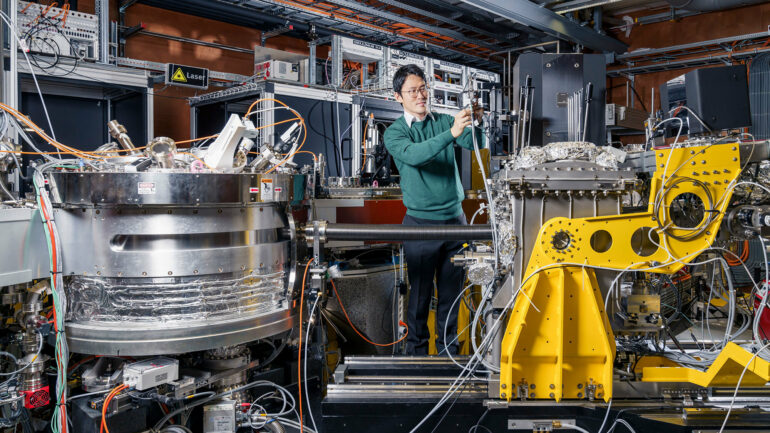Scientists have revealed how lattice vibrations and spins talk to each other in a hybrid excitation known as an electromagnon. To achieve this, they used a unique combination of experiments at the X-ray free electron laser SwissFEL. Understanding this fundamental process at the atomic level opens the door to ultrafast control of magnetism with light.
Within the atomic lattice of a solid, particles and their various properties cooperate in wave-like motions known as collective excitations. When atoms in a lattice jiggle together, the collective excitation is known as a phonon. Similarly, when the atomic spins—the magnetization of the atoms -move together, it’s known as a magnon.
The situation gets more complex. Some of these collective excitations talk to each other in so-called hybrid excitations. One such hybrid excitation is an electromagnon. Electromagnons get their name because of the ability to excite the atomic spins using the electric field of light, in contrast to conventional magnons: an exciting prospect for numerous technical applications. Yet their secret life at an atomic level is not well understood.
It’s been suspected that during an electromagnon, the atoms in the lattice wiggle, and the spins wobble in an excitation that is essentially a combination of a phonon and a magnon. Yet since they were first proposed in 2006, only the spin motion has ever been measured. How the atoms within the lattice move—if they move at all—has remained a mystery. So, too, understands how the two components talk to each other.
Now, in a sophisticated series of experiments at the Swiss X-ray free-electron laser SwissFEL, researchers at PSI have added these missing pieces to the jigsaw. “With a better understanding of how these hybrid excitations work, we can now start to look into opportunities to manipulate magnetism on an ultrafast timescale,” explains Urs Staub, head of the Microscopy and Magnetism Group at PSI, who led the study.
First the atoms, then the spins
In their experiments at SwissFEL, the researchers used a terahertz laser pulse to induce an electromagnon in a crystal of multiferroic hexaferrite. Using time-resolved X-ray diffraction experiments, they then took ultrafast snapshots of how the atoms and spins moved in response to the excitation. With this, they proved that the atoms within the lattice really do move in an electromagnon and revealed how energy is transferred between lattice and spin.
A striking outcome of their study was that the atoms move first, with the spins moving fractionally later. When the terahertz pulse strikes the crystal, the electric field pushes the atoms into motion, initiating the phononic part of the electromagnon. This motion creates an effective magnetic field that subsequently moves the spins.
“Our experiments revealed that the excitation does not move the spins directly. It was previously unclear whether this would be the case,” explains Hiroki Ueda, beamline scientist at SwissFEL and the first author of the publication.
Going further, the team could also quantify how much energy the phononic component acquires from the terahertz pulse and how much energy the magnonic component acquires through the lattice. “This is an important piece of information for future applications in which one seeks to drive the magnetic system,” adds Ueda.
One free electron laser, two beamlines, two crystal modes
Key to their discovery was the ability to measure both the atomic motions and the spins in complementary time-resolved X-ray diffraction experiments at the hard and soft X-ray beamlines of SwissFEL.
Using hard X-rays at the Bernina experimental station, the team studied the motion of atoms within the lattice. The recently developed set-up of the experimental station, including specially designed sample chambers, allows unique ultrafast measurements using terahertz fields in solids at very low temperatures.
To study the motion of the spins, the team used soft X-rays, which are more sensitive to changes in magnetic systems. These experiments were performed at the Furka experimental station, which recently entered user operation. By tuning the X-ray energy to a resonance in the material, they could focus specifically on the signal from the spins—information that is usually masked.
“The measurement of the phononic part alone at Bernina was a major step forward. To also be able to access the magnetic motion with Furka is an experimental possibility that exists almost nowhere else in the world,” comments Staub.
Fundamental principle is important for our understanding of other physical processes
Ueda, Staub and colleagues have provided an understanding of the microscopic origin of an electromagnon. This understanding is important not only to this physical process but in a more general sense.
The fundamental interactions between lattice and spins underpin many physical effects that give rise to unusual—and potentially very useful—material properties: for example, high-temperature superconductivity. Only with a better understanding of such effects comes control.
The study is published in the journal Nature Communications.
More information:
Hiroki Ueda et al, Non-equilibrium dynamics of spin-lattice coupling, Nature Communications (2023). DOI: 10.1038/s41467-023-43581-9
Provided by
Paul Scherrer Institute
Citation:
The secret life of an electromagnon: Research takes a step toward ultrafast control of magnetism with light (2023, November 28)



